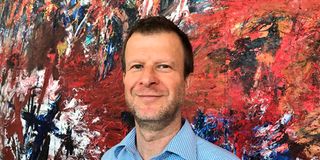Preventing suicide: Quest for sensitive reporting and increased funding

Dr Mark Van Ommeren, head of mental health in the Department of Mental Health and Substance Use at the World Health Organization.
What you need to know:
- The World Health Organization estimates more that 700,000 people globally die by suicide. Among adolescents and young adults aged 15-29 years, suicide is the fourth leading cause of death.
- Kenya is still among countries that criminalise suicide. This is despite being among the nations with the highest suicide rates.
Kenya is still among countries that criminalise suicide. This is despite being among the nations with the highest suicide rates.
Healthy Nation caught up with Dr Mark Van Ommeren,the head of mental health in the Department of Mental Health and Substance Use at WHO, on the sidelines of the Global Mental Health Action Network meeting in Cape Town, South Africa, where he spoke about creating suicide awareness, prevention, promoting sensitive reporting and increasing mental health funding.
B: Why you are attending the Global Mental Health Action Network?
More than 46 countries are represented at this meeting. We have people who want the world to move forward on mental health matters — people with lived ill mental experience, their care-givers, mental health service providers, and local and international NGOs . What’s interesting about this meeting is that it is an opportunity for people with different perspectives to meet and align advocacy for mental health across the world. This is where bottom-up meets top- down.
B: Why has media been accused of promoting mental health stigma and discrimination?
The media is likely to reflect the attitudes of people around the world. Unfortunately, in mental health, a lot of stigma results in discrimination and human rights violations. The stigma needs to be wiped out, but that is easier said than done. The media can start talking about mental health in ways that do not make people with mental illness look bad and this will help in eliminating self-stigma. We can describe self-stigma as when someone withdraws from society because of negative perceptions of mental illnesses. It is important for the media to get up to speed with eliminating mental health stigma. For example, with suicide, there is a way we can talk about it without stigmatising.
B: WHO is revising its guidelines on mental health reporting why is this important?
This is a document we are revising for the second time. This will be the third version because the media changes all the time. Digital media is big now and so we are updating our guidelines all the time. We are emphasising media reporting on suicide so that it is done in a way that does not inspire people to end their lives. The media should cover suicide but not mention the methods.
B: Why is creating awareness on suicide prevention important?
There are a number of ways of preventing suicide that all societies should adopt. The most effective way is reducing easy access to means of suicide like toxic pesticides; they should not be accessible for people in the community. Young people need to learn life skills, how to cope with the difficulties of life because it is inherent that life will be difficult at one point or the other. When people make an attempt to end their lives, it is important for health services to take the right follow-up actions. When someone is at imminent risk of suicide, ensure they are not alone until the risk reduces.
B: There’s growing concern about the state of mental health across the world and financing, why is mental health still underfunded compared with other diseases?
The budget for mental health in most countries in the world, and certainly in most African countries, is too small. The budget for health generally needs to increase, and that increase needs to be partially used to have more funding for mental health. The money available right now for mental health doesn’t even reach the tip of the iceberg. There is a need for new funding for mental health. Governments need to think about why their health budgets are small and if they are really serious about mental health, then they need to ensure health and other sectors have the funding to address mental health issues.
What other gaps in mental health have you come across apart from stigma and discrimination?
Mental health issues are common. About a billion people in the world have a mental health condition and they have caregivers – family members and other loved ones. Mental health caregivers are not talked about, yet they care deeply and are the number one resource that people turn to for help. We hardly talk about caregivers. I am not saying they are the solution; they can be the problem, but overall, we need to engage caregivers. They are motivated, but it can be exhausting and emotionally challenging to take care of someone who is mentally ill.
What is your rallying call as the world marks World Suicide Prevention day?
We need to strengthen the conversation between decision-makers and people on the ground, that is people with lived experience of ill mental health, caregivers and local mental health service providers so that the decisions made benefit those in need.





